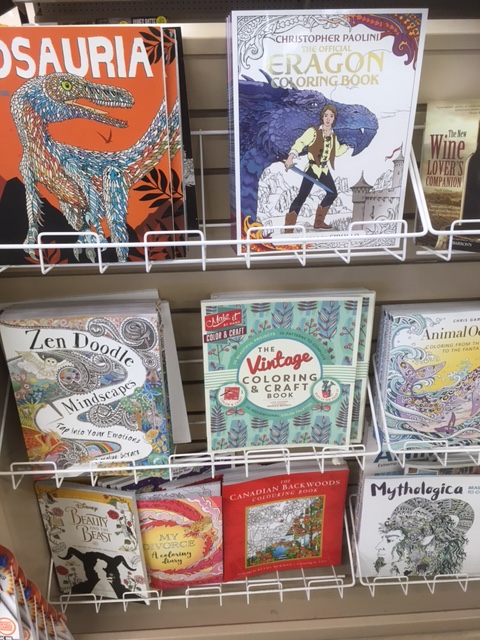
In the United States in 2016, adult coloring book sales topped $14 million compared to $10 million in 2015. Recently, sales have slowed down, possibly because the books have reached the saturation point. But that’s a lot of people who still believe the books are beneficial.
Last week there were still over 200 different adult coloring books listed at the Amazon website alone – ranging in price from a few dollars to over $20 each. Although using your children’s books may be just as relaxing, adult coloring books sport higher quality paper, more intricate designs, and a wider selection of themes.
I snapped the accompanying photo of a magazine section in my local supermarket, showing the extent that adult coloring books are encroaching on valuable rack space.
Are people regressing to childhood activities in an attempt to escape work and/or responsibility? Will executive sandboxes be making a comeback soon? Or are people finding it difficult to find an adult hobby? Is it an example of the “cocoon” lifestyle where we avoid interacting with other people? Or can people not find more productive ways to use their time?
No, these aren’t the reasons why so many people are taking to coloring within the lines of sketches, designs and geometric shapes.
Although adult coloring books are mostly marketed to harried adults looking to relieve stress, they are also claimed to expel negative thoughts, help you achieve mindfulness, distract you from the daily pressures of life, release your creativity and allow you to experience relief by altering your meditative state. There are even reports of lowering blood pressure and reducing heart rates.
There is some disagreement over the therapeutic benefit of coloring books, and they are not a replacement for art therapy, meditation, yoga or prayer; but the books have been known to help switch off your brain and elicit a relaxation mindset. So this does make them stress relievers.
Focusing on anything, whether it’s a coloring book or not, does consume less energy, and giving the brain’s amygdala a rest has to be a good thing. It’s definitely more difficult to worry or obsess over problems and still color mandala patterns at the same time. And engaging in a childish pastime made accessible and acceptable to adults should be a welcome diversion for many hard-working executives.
But isn’t it a waste of time?
Not really. It has already been proven that working in chunks of time, such as 90 minutes, separated by relaxing breaks – or at least a change of pace – aids personal productivity. Perhaps coffee breaks should be replaced by coloring breaks. Or it might at least be a good transitioning activity as you transfer your mind and body from work to home.
Coffee breaks are usually not free of interruptions. In fact the amygdala part of our brain is constantly on the lookout for interruptions. Interruptions involve multitasking, which in turn causes stress and consumes more energy. Focusing, on the other hand, consumes less energy and puts the amygdala in an idle mode.
I have actually never heard of “color breaks.” But literature on the topic of coloring books includes a mention of their use by students in classrooms. They can more effectively concentrate on the lecture while coloring. But isn’t that multitasking? Not really, since the coloring becomes a habitual, mindless activity that allows greater focus than if the student were fidgeting and unable to stay still.
This makes even more sense to me when I realize that the inability to focus is often a symptom of anxiety and stress. And I must apologize to my lady friend who insists on knitting when we are visiting with other people. She is actually increasing her focus on the conversations.
I still resent the time it takes to color; and I prefer physical exercise as a way to focus while enhancing cognitive health. But certain neurologists and neuropsychologists have convinced me of its therapeutic properties, and I plan to look into it further. In fact I wonder if the colors used would have an impact – as they do in office design. For instance, as I mentioned in my eBook on the impact of the environment on personal productivity (published by Bookboon.com), blue and green have been found to be the most effective in stimulating personal productivity, and green has also been associated with calm and well-being.
Health is even more important than time since without it, time is stripped of much, if not all, of its effectiveness. And there is little doubt of the negative impact of excessive stress on our health and well-being. Today there is no shortage of negative stressors – from workload, deadlines and difficult people – to constant interruptions from calls, email and text messages.
Few people will disagree that the digital age of speed can be physically, mentally and emotionally draining. Merging high-tech with high touch provides a way of unwinding and recharging so you can replenish depleted energy.
Coloring can be viewed as self-care, and a way of maintaining balance in an otherwise go-go-go environment. You have no doubt heard the expression, “All work and no play makes Jack a dull boy.” Well, perhaps adding some bright colors to the situation might prevent that from happening.


Recent Comments